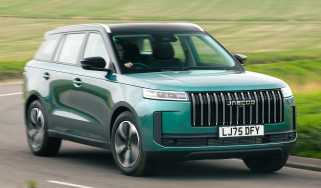How to get your motorcycle licence: theory, module 1 and module 2 tests explained
Our complete guide to the tests you need to take to get any motorcycle licence in the UK
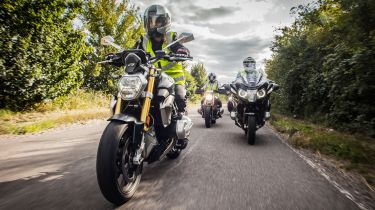
Getting a motorcycle licence in the UK is much more complex than getting a car licence. It isn’t quite as simple as just passing a theory and practical test. There are various different motorcycle licence categories, which are impacted by your age and determine the type of bike you are allowed to ride.
Knowing which motorcycle license you need before getting in the saddle can feel like a test in itself. Whatever your age or riding aspirations, we’ve broken down the path you’ll need to take in order to get your motorcycle licence.
Types of motorcycle licence
In the UK there are four main categories of motorcycle licence. All but one of these categories limit you on the motorcycle you can ride once you’ve passed, with age also playing a factor.
AM
The AM category is the most basic motorcycle licence you can get in the UK, but it applies more to mopeds than motorbikes. An AM licence allows you to ride two-wheel and three-wheel vehicles with a top speed of 28mph, plus light quadricycles that weigh less than 350kg and have the same top speed. You must be 16 or older to get an AM licence.
A1
Once you turn 17 you can get an A1 licence. Those that do can buy a 125cc motorcycle that produces no more than 11kW (15bhp) and has a power-to-weight ratio of 0.1 kW per kg at most. It also allows you to ride tricycles that produce up to 20bhp.
A2
If you’re 19 or older you can get an A2 licence. This allows you to ride motorcycles that produce up to 35 kW (47bhp), and have a power-to-weight ratio of no more than 0.2 kW per kg.
There are lots of A2-compatible motorcycles on the market, while some manufacturers offer restricted versions of more powerful models that are compliant. If you want a motorbike which isn’t A2 compliant, there are special restriction kits available.
A
Finally, there’s the A category motorcycle license. Category A is the same as a full UK car licence in that there is no restriction on the power output of the motorcycle that you’re allowed to ride.
You have to be 24 or older in order to get an A licence via the direct access route, though, or you can get it after you turn 21 if you’ve held an A2 licence for at least two years and complete the Module 1 and Module 2 practical tests again.
Riding with a provisional licence
In the UK you can ride a motorbike of up to 50cc when you’re 16 years old or 125cc if you’re 17 and over.
To do so, you’ll need to have a provisional driving licence and complete your Compulsory Basic Training.
If you don't already have a provisional driving licence, you can apply for one online at the GOV.UK website, or by completing a D1 ‘Application for a driving licence’ which is available at most Post Offices.
A provisional driving licence costs £34.
Once you have your provisional driving licence and have completed your CBT, you can ride unsupervised on the road, although you must display L plates (L or D plates in Wales), you’re not allowed to carry pillion passengers or ride on the motorway.
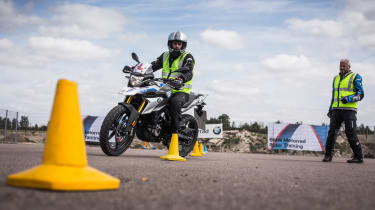
How to get a motorcycle licence
There are a total of four tests which you need to pass before you get your hands on any UK motorcycle licence. These are:
- CBT (compulsory basic training)
- Motorcycle theory test
- Module 1
- Module 2
CBT (compulsory basic training)
If you couldn’t tell by the name, compulsory basic training (otherwise known as CBT) is the fundamental schooling everyone must complete before being allowed to hit the streets unsupervised. We have a full guide to passing your CBT, but we’ll give you the abridged version anyway.
CBT can be broken down into five major sections, starting with a classroom session on the clothing and protected equipment you should be wearing when riding a motorcycle. That includes helmets, boots and gloves, as well as the safety standards and rating that applies to them, so you know what to look for when you buy your own gear (if you haven’t already).
Next up is an introduction to the motorcycle itself, where you’ll walk around the bike you’re going to be riding, learning where the controls are on the bike and how to operate them. This portion of the CBT also teaches you about the daily and weekly checks you need to carry out on a motorcycle to make sure it’s roadworthy.
After all that, you’ll finally get to ride a motorcycle, although it won’t be on the road at this stage. Instead, you’ll spend time on a test pad of some kind, learning how to move away, clutch control, stopping, changing gear and stability as you change direction.
You’ll then return to the classroom to prepare to ride on the road for the first time. This involves discussing how you approach roundabouts, junctions and some of the other scenarios you can expect to encounter.
At this point, if the instructor is confident in your abilities, you’ll finally get a chance to head out on the highway. To complete your CBT you must spend a minimum of two hours riding on the road, with your instructor guiding you the entire time. This isn’t a test, rather a training course where you’re assessed throughout.
If you’ve met the standard required, you’ll be handed your CBT certificate, which allows you to legally ride a motorcycle or scooter of up to 125cc on the road, so long as it’s fitted with L-plates.
You can’t go on motorways and can’t carry pillion passengers, while a CBT certificate is valid for two years. You can either move on and take the other tests at this time, or you must retake your CBT when the two years are up.
Motorcycle Theory test
If you’ve taken the car theory test not so long ago, then you’ll have some serious deja vu with the motorcycle theory test, because the experience is exactly the same.
You sit in a little cubicle with nothing but a computer, are given 50 multiple-choice questions, including some situational questions, then are shown clips to test your hazard perception.
The pass mark currently sits at 43 correct out of 50 for the multiple choice, while for the Hazard Perception you’ll need a minimum of 45 out of an available 75.
Before you start thinking you’ll breeze through this, especially if you’ve been driving for decades or have an encyclopaedic knowledge of road signs, the motorcycle theory test does include questions specifically about motorcycles – I know, it’s cruel!
These can be about maintenance, equipment and rules and guidance regarding pillion passengers, to name but a few of the topics you might be quizzed on.
That means you’re going to have to study, but there are plenty of books available or, if you prefer, mock tests you can take ahead of time. You should also brush up on your hazard perception skills too, especially if you learnt to drive before the modern theory test was introduced in 1996.
It’s worth noting that you can take your theory test before completing your CBT, which you’ll have to do if you plan on enrolling in a direct access course like we did. In fact, you’ll be required to present your theory test certificate at the start of courses such as these.
Once you’ve passed your motorcycle theory test, it’s also valid for up to two years.
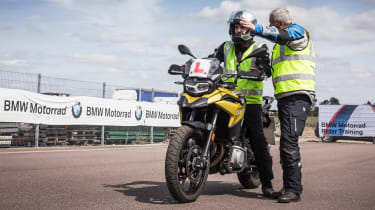
Module 1 test
The penultimate hurdle to obtaining any motorcycle licence is the Module 1 test, where you must demonstrate your ability to control a motorcycle safely in a wide variety of situations.
The Module 1 test doesn't take place on the road, instead you go to a purpose-built facility adorned with plastic cones that you know are completely harmless, yet still manage to strike fear into the hearts of new riders.
The Module 1 test includes seven individual components, the first of which are fairly straightforward:
- Manual handling – you’ll have ridden into a parking space and you then have to push the bike from that bay into the next
- Slalom between cones before going into figures of eight – pretty self-explanatory
- Slow ride – riding as though you’re in slow moving city traffic, travelling at around 4mph
- U-turn – again, pretty self-explanatory
The final three exercises all begin by riding around a bend, which also gives you an opportunity to show you can handle cornering on a motorcycle.
You’ll also pass through a speed gate after exiting the bend because you must be travelling at or around 50kph (32mph) when you complete the final two exercises.
Your examiner will ask you to redo them if you’re going too slowly and you have two chances for both, so don’t sweat it if you don’t nail your speed the first time round.
- Controlled stop – after passing through the speed trap followed by a set of cones, you’ll have to slow gently so you stop with your front wheel within a box
- Emergency stop – after passing through the speed gate, your examiner gives you a signal, bring your bike to a stop as quickly as possible, but still in a safe, controlled manner
- Avoidance exercise – pass through the speed trap a final time before steering through a set of cones, as though you’re avoiding something that’s appeared in the road. After you've straightened up, bring the bike to a stop.
Top tips for passing the Module 1
When you’re on the test pad you must behave as if you were on the public road.
That means carrying out your mirror checks and lifesavers (a look over each shoulder to check the area that the mirrors don’t cover) before pulling away, and checking your mirrors after you’ve completed your controlled stop, emergency stop and avoidance exercise.
Avoid hitting any of the plastic cones throughout the exam because if you do you’ll instantly fail your Module 1. Something we witnessed several times before our exam.
Even after all those, when the examiner ushers you off the test pad, you still need to carry out your checks. If you don’t, that’s deemed a minor fault.
Speaking of which, you cannot make more than five minor faults or any major faults in the Module 1 test, otherwise you fail.
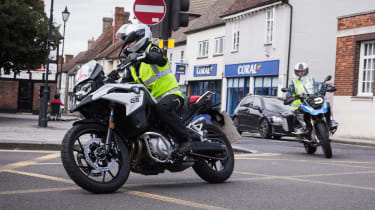
Module 2 test
This might well be the final test of the lot, but if your instructor has trained you well enough, then it should also be easiest.
As with the practical test for cars, you’ll go to your chosen DVSA test centre to meet your examiner, who will either follow behind you on their own motorcycle or in a car.
The exam begins with you reading a licence plate from at least 20 metres away. Your examiner will then ask you three random ‘show me, tell me’ questions about motorcycle maintenance, the controls of your bike and any checks you might need to carry, plus one additional question specifically about pillion passengers.
All being well, you’ll then set out on the 30-40 minute riding test, with the examiner providing your directions via an earpiece – just like you’ll have had while learning on the road with your instructor.
Obviously we don’t know what situations you’ll face on your test, because it depends on where you take your test, as well as the random actions of other motorists, cyclists and pedestrians.
What we do know is that you’ll be asked to complete a few types of stops during your test: pulling up behind a parked car, a hill start, stopping where and when you think it’s safe to do so, and then moving away when it’s safe to do so.
For the Module 2 test, you can make up to 10 minor faults and still pass, but any serious or major faults will result in a fail.
And that’s all there is to it – once you’ve passed all four tests, you’ve got yourself a motorcycle licence.
Why ride a motorcycle?
There are a number of reasons why you might opt for two wheels rather than four.
If you live in a city, work as a food delivery driver or courier time-critical medicines to hospitals and vulnerable patients, zipping down city streets or filtering through lines of gridlocked traffic on a motorcycle can help slash your journey times.
Motorcycles are typically cheaper to run than their four-wheeled equivalent with running costs, maintenance, VED road tax and the dreaded petrol station fill-up being more affordable. Of course there are variables here, a brand-new Honda Super Cub 125cc scooter is obviously going to cost less overall than something like a Ducati Panigale V2 MM93 superbike.
That’s before we get to the undeniable allure of hitting the open road on two wheels. Whether that’s to find a greater sense of freedom, carve up some B-roads on the weekend or conquer continents on adventures like Ewan McGregor and Charley Boorman, there are plenty of reasons to ride a motorcycle based around enjoyment.
Get even more from Auto Express, follow our channels...
• Google
• Reddit
• Whatsapp
Find a car with the experts




